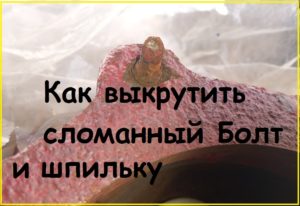
Let's divide the possible cases into two main categories: either a bolt fragment protrudes from the product, or not.
When starting to remove a broken hairpin, you should first try simple methods. And if nothing works out, only then move on to more time-consuming ones.
How to unscrew a broken bolt if the chip protrudes even a little from the product.
In any case, before doing anything with this fragment, it is worth treating the threads with WD-40. If possible, heat this place with a gas burner or a building hair dryer, let it cool down and treat it again with a WD. Such actions will facilitate your further manipulations.
Method 1.
In the simplest case, a chisel will help you (and if you don’t mind, then a screwdriver can fit on small studs).
Point the chisel at the edge of the protruding pin, tilting it so that hitting it can cause the pin to rotate in the direction of unscrewing the product from the array.
If you managed to turn the pin a couple of turns, it will be more convenient to unscrew it with the help of pliers or a gas wrench.
If the hairpin sits deafly and you cut off the remnants of the hairpin by your actions, for which you could somehow catch on, see one of the following methods.
Method 2.
A very effective method on large studs, but electric welding is needed for its implementation.
A nut is installed on top of the fragment of the stud (it is advisable to put a sheet of paper with a hole cut out in it along the diameter of the stud), with a larger size (1-2 sizes larger than the stud). For example, if you are trying to unscrew the M 12 stud, then you are using the M 14 nut.
Make several tacks between the inner surface of the nut and a piece of stud.
Unscrew with a wrench of the appropriate size.
Method 3.
If the chip protrudes 2-3 mm above the surface of the product, you can try to make a slot for a screwdriver in it.
You can make it either with a grinder (thin disk) or with a manual hacksaw for metal.
Unscrew with a screwdriver.
This method can be applied even in the case when the chip does not protrude above the surface, but then you have to cut the "body" of the product. If this is not critical, you can try this method.
How to unscrew a broken bolt if the chip does not protrude above the surface of the product.
Method 4.
If you have a left-hand drill, you can try to unscrew it.
Drill Diameter = Stud Outer Diameter - Tooth Height x 2
In the center of the stud, make a recess with a core. In the resulting recess, install the usual "right" thin drill. Drill 1-2 cm.
Then install the “left” drill of a larger diameter in the chuck and drill at low speeds.
The peculiarity of the method is that the "Left" drill drills counterclockwise, which coincides with the direction of unscrewing the pin. And if it is not very sticky, during the drilling process, the pin may begin to turn.
Method 5.
Extractor.
Drill a hole in the center of the stud with a diameter corresponding to the type of extractor.
Insert the extractor into the resulting hole and unscrew your hairpin.
Method 6.
Drill a hole in the stud, cut a thread in it with a tap.
Screw in the corresponding bolt, tighten it with a counter-nut, unscrew the stud with a wrench thrown over the head of the fixed bolt.
Method 7.
Choose a right-hand drill with a diameter as in "Method 4".
Drill a stud all the way through the hole. The idea of the method is as follows: in the body of the thread of the product, only the teeth of the thread of the stud will remain, which can be removed with a tap.
With a tap of the same diameter as the diameter of the stud, drive the thread in the product array.
The main condition for the successful implementation of this method is the exact placement of the drill in the center of the stud. Otherwise, you will spoil the thread in the array of the product.
If the thread was broken during the dismantling of the stud, it makes sense to drill the damaged hole for the next thread size and cut a new thread of a larger diameter with a tap.
Method 8.
If the stud breaks off in an aluminum array, you can use nitric acid (it's hard to find, but suddenly you have it).
Pour the blaster with acid. It corrodes steel, leaving aluminum (or duralumin) intact. When the remains of the stud are removed, do not forget to neutralize the acid in the hole with an alkali (for example, soda).
The process is of course lengthy, so it is suitable if you are not in a hurry.
Method 9.
Drill a hole in the stud and drive into it either a triangular file or a tap sharpened under a cone with three edges.
Unscrew the pin by rotating the wedged file or tap.